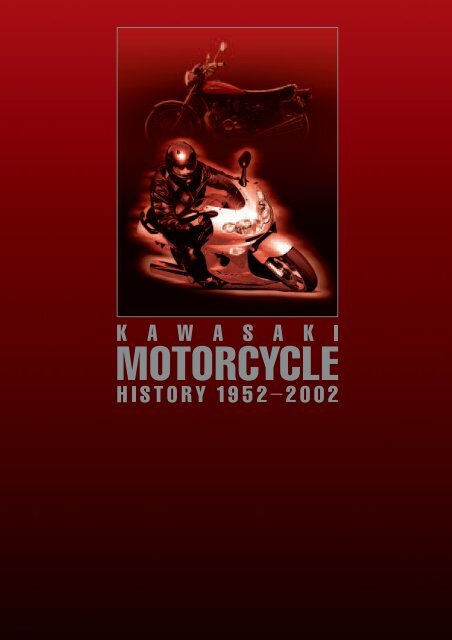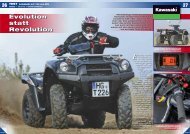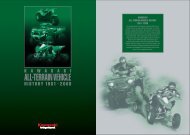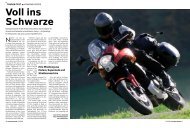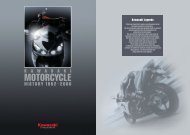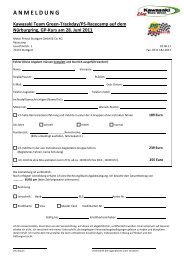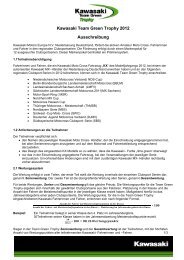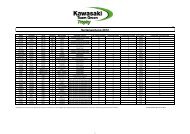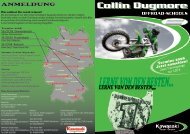Kawasaki Legends - Roadrunner
Kawasaki Legends - Roadrunner
Kawasaki Legends - Roadrunner
Create successful ePaper yourself
Turn your PDF publications into a flip-book with our unique Google optimized e-Paper software.
<strong>Kawasaki</strong> <strong>Legends</strong><br />
Forty years have passed since <strong>Kawasaki</strong> started<br />
full-scale production of motorcycles.<br />
Our first motorcycle engine was designed based on technical<br />
know-how garnered from the development and<br />
production of aircraft engines.<br />
Our entry into the motorcycle industry was driven by<br />
<strong>Kawasaki</strong>’s constant effort to develop new technologies.<br />
Over the years we have released numerous new models<br />
that have helped shape the market, and in the<br />
process created many enduring legends based<br />
on the speed and power of our machines.<br />
In 1996, we produced our 10 millionth vehicle,<br />
a testament to <strong>Kawasaki</strong>’s ability to meet the<br />
needs of a wide range of riders.<br />
As <strong>Kawasaki</strong> continues to “Let the good times roll,”<br />
our latest challenges will surely give birth to new legends…
KZ900-A<br />
4-stroke<br />
Air-cooled In-Line Four<br />
DOHC, 16 valves<br />
903 cm 3<br />
ZX1100-C<br />
4-stroke<br />
Liquid-cooled In-Line Four<br />
DOHC, 16 valves<br />
1,052 cm 3<br />
ZX1200-C<br />
4-stroke<br />
Liquid-cooled In-Line Four<br />
DOHC, 16 valves<br />
1,164 cm 3<br />
KH500-A<br />
2-stroke<br />
Air-cooled In-Line Triple<br />
Piston valves<br />
498 cm 3<br />
ZX900-A<br />
4-stroke<br />
Liquid-cooled In-Line Four<br />
DOHC, 16 valves<br />
908 cm 3<br />
ZX1200-A<br />
4-stroke<br />
Liquid-cooled In-Line Four<br />
DOHC, 16 valves<br />
1,199 cm 3
1950 1960<br />
1952 1960<br />
Design of the KE-1 Motorcycle Engine is<br />
completed. (<strong>Kawasaki</strong> Machine Industry (the<br />
precursor to <strong>Kawasaki</strong> Aircraft Company),<br />
Takatsuki Factory)<br />
“Aircraft engineers” began development of the<br />
KE (<strong>Kawasaki</strong> Engine) in 1949. Mass production<br />
starts in 1953. The air-cooled, 148 cm 3 , OHV,<br />
4-stroke Single has a maximum power of 4 PS<br />
at 4,000 rpm.<br />
1955<br />
Meihatsu 125-500<br />
Production of the KB-5 Motorcycle Engine<br />
starts. (<strong>Kawasaki</strong> Aircraft Company, Kobe<br />
Plant)<br />
Its responsive torque at low and mid rpm, and<br />
outstanding characteristics give it a good<br />
reputation among riders. For the next 10 years<br />
the KB-5, while receiving a number of updates,<br />
provides the base for <strong>Kawasaki</strong>’s 125 cm3 motorcycle engine.<br />
The Meihatsu 125-500, equipped with the<br />
KB-5, is released. 1956 sees the debut of the<br />
Meihatsu 125 Deluxe.<br />
In 1957, production of an improved version of<br />
the KB-5 engine, the KB-5A, commences. The<br />
“<strong>Kawasaki</strong>” logo is stamped into the side cover<br />
for the first time.<br />
Meihatsu 125 Deluxe<br />
KE-1<br />
KB-5<br />
“A Durable <strong>Kawasaki</strong> Engine”<br />
The Meihatsu 125 Deluxe (<strong>Kawasaki</strong><br />
Meihatsu Industries) achieves a top speed<br />
of 81.5 km/h at a motorcycle industry<br />
magazine test, setting a record for its<br />
category. In a separate test, the <strong>Kawasaki</strong><br />
engine proves its phenomenal durability by<br />
running for 50,000 km without breaking<br />
down.<br />
1961<br />
1962<br />
1963<br />
1966<br />
1969<br />
<strong>Kawasaki</strong><br />
125 New Ace<br />
<strong>Kawasaki</strong> Pet<br />
<strong>Kawasaki</strong> 125B8<br />
A factory dedicated exclusively to<br />
motorcycle production is completed.<br />
Sales of the <strong>Kawasaki</strong> 125 New Ace<br />
commence.<br />
Sales of the first <strong>Kawasaki</strong> brand motorcycles, the <strong>Kawasaki</strong> Pet and<br />
<strong>Kawasaki</strong> 125B7, commence. Using the most advanced materials of<br />
the time, their curved surface compositions give them high-sense<br />
designs.<br />
Sales of the <strong>Kawasaki</strong> 125B8 commence. Developed and<br />
manufactured exclusively by <strong>Kawasaki</strong> Aircraft Company, the B8’s<br />
low-end torque, quiet engine and supreme durability earn it the<br />
reputation as the No. 1 practical use bike.<br />
The B8M Motocrosser takes the top 6 positions in the Hyogo Prefecture Motocross Tournament.<br />
The Fearsome “Red-Tank Furore”<br />
With all the <strong>Kawasaki</strong> bikes completing the race, they prove that<br />
“<strong>Kawasaki</strong>s are strong machines on tough circuits”. Later, at the<br />
Fukui Prefecture Motocross Tournament, <strong>Kawasaki</strong> machines<br />
win all the race events; at various motocross tournaments held<br />
in West Japan, <strong>Kawasaki</strong> machines are victorious in most of the<br />
events – despite not competing the past year. The outstanding<br />
achievements of the “Red-Tank Furore”, named for its red fuel<br />
tank, earn it a fearsome reputation.<br />
H1<br />
W1<br />
A1<br />
Sales of the H1 (500 cm 3 ) (500SS Mach-III in Japan)<br />
commence. The air-cooled 2-stroke Triple, is the fastest<br />
machine in its class with a top speed of 200 km/h.<br />
Nicknamed “Bronco”, the H1 marks the beginning of<br />
<strong>Kawasaki</strong>’s Speed King Legend.<br />
B8M<br />
Popularity of the W1 (650 cm3 ) (650W1 in Japan) in the<br />
US gains <strong>Kawasaki</strong> world-wide recognition as a big bike<br />
manufacturer.<br />
Sales of the A1 (250 cm3 ) commence. The first bike in its<br />
class to be equipped with an air-cooled, 2-stroke, parallel<br />
twin, rotary disc valve engine, the A1 demonstrates<br />
phenomenal performance.<br />
Noteworthy GP Racing Achievements<br />
In the final race of the 1966 FIM World Championship,<br />
<strong>Kawasaki</strong>’s first 125cc GP racer, the KAC Special,<br />
finishes in 7th and 8th. In the All-Japan<br />
Championship, the A1R (250 cm<br />
A1R<br />
3 ) finishes 2nd. In the<br />
1967 Singapore GP, the A7R (350 cm3 ) takes 1st and<br />
2nd; the A1R finishes 2nd and 3rd. In the Japan<br />
Round of the 1967 FIM World Championship,<br />
the KA-2, a liquidcooled,<br />
124 cm3 V4<br />
equipped with the<br />
world’s first all rear<br />
exhaust mechanism,<br />
takes 3rd and 4th<br />
showing <strong>Kawasaki</strong>’s<br />
technological<br />
prowess.<br />
Expectant World Champion<br />
Shines<br />
In the 125cc class FIM World Road<br />
Racing Championship, Dave Simmons,<br />
with victories in the West German GP<br />
and the Isle of Mann TT, wins the<br />
series championship on a KR-1.
1970 1980<br />
1972<br />
1977<br />
1978<br />
1979<br />
Overseas sales of the Z1 (900 cm 3 ) start.<br />
Sales of a domestic version, the Z2 (750 cm 3 ), start the following year.<br />
Z1<br />
Birth of the Power King Legend<br />
The Z1, with the world’s first air-cooled, DOHC, In-Line Four and<br />
other impressive specs, becomes the world’s most powerful<br />
motorcycle. Code-named “New York Steak” during its five-year<br />
development, the mouth-watering motorcycle is a huge hit from the<br />
moment of its release. The domestic Z2 also enjoys tremendous<br />
popularity in Japan.<br />
Overseas the Z1 reigns as the “King of Motorcycles” for a number<br />
of years. Z1-mania still endures in present day. In Japan, the<br />
popularity of the Z2 among motorcycle magazine readers catapults<br />
it to No. 1; the “Myth of Z” is born.<br />
Z1-R<br />
Z1300<br />
Z400FX Z250FT<br />
Sales of the Z1-R<br />
(1000 cm 3 ) commence.<br />
A real-style cafe racer, the<br />
Z1-R’s stylish appearance<br />
receives great praise<br />
overseas.<br />
Sales of the Z1300<br />
commence. At 1300 cm 3 ,<br />
the liquid-cooled, 4-stroke,<br />
DOHC In-Line 6-cylinder<br />
“Dreadnaught” is the<br />
largest Japanese<br />
manufactured machine.<br />
Its release at the Cologne<br />
Motor Show marks the<br />
beginning of the <strong>Kawasaki</strong><br />
Monster Legend.<br />
Sales of the Z400FX commence. The first air-cooled, 4-stroke, DOHC<br />
In-Line-Four in its class, the “FX” makes a name for itself. Its large<br />
frame (from a machine one class higher), compact engine and<br />
no-compromise quality make it a big hit.<br />
The same year, the Z750FX and the Z250FT are released and enjoy a<br />
favourable reception.<br />
KZ440LTD Z250LTD<br />
The first Japanese mass-produced belt-driven motorcycle, the<br />
KZ440LTD, is manufactured for the US market. This is one example of<br />
<strong>Kawasaki</strong>’s “Spirit of Embracing Challenge”.<br />
The same technology is used in two domestic models, the Z250LTD,<br />
and the Z400LTD starting in 1983.<br />
1980<br />
1981<br />
1982<br />
1983<br />
1984<br />
1985<br />
Overseas sales of the Z1100GP commence. The first model in the<br />
supersport GP line-up is the first <strong>Kawasaki</strong> to feature DFI (Direct Fuel<br />
Injection) and an oil cooler.<br />
KR250<br />
AR50<br />
<strong>Kawasaki</strong> wins the manufacturer’s title in the 250cc class FIM World Road<br />
Racing Championship for the fourth year in a row. The machine is the<br />
KR250. A. Mang wins the rider’s title in both the 250cc and 350cc classes.<br />
Sales of the AR50 commence. <strong>Kawasaki</strong>’s first 50 cm 3 sports model is<br />
also the first 6-speed machine in its class.<br />
Z1000R GPz400<br />
Sales of the Z400GP, a domestic model in the GP line-up, commence.<br />
Overseas sales of the Z1000R commence. The legendary model is a<br />
limited edition replica commemorating Eddie Lawson’s 1981 AMA<br />
Superbike Championship victory. Based on the Z1000J, the “Lawson<br />
Replica” features the latest technology, like an oil cooler, and lime green<br />
colouring.<br />
Overseas sales of the GPz1100 commence. The new sports model<br />
features DFI and Uni-Trak suspension.<br />
The following year, sales of other models in the series, the GPz750 and<br />
the GPz400 commence.<br />
The Z750 Turbo is released. Often referred to as “the pinnacle of<br />
air-cooled machines” at Fuji Speedway and the like, this is <strong>Kawasaki</strong>’s first<br />
turbo-charged supersport.<br />
The GPz900R is released in Monterey, California at a press introduction<br />
and test riding session. Sales of the first “Ninja” (US naming) commence<br />
the following year.<br />
GPz900R<br />
Ninja named “Bike of the Year”<br />
The GPz900R rocks the world when it is released. The new model is<br />
equipped with <strong>Kawasaki</strong>’s first liquid-cooled, DOHC, 16-valve 4-cylinder<br />
engine (max power is 115 PS) and a light, compact chassis. With a top<br />
speed of more than 250 km/h and able to run the 0-400 m in 10.552 s<br />
the GPz900R rewrites the motorcycle record books and takes the top<br />
spot as the world’s fastest bike. When sales start in 1984, it is named<br />
“Bike of the Year” by magazines all over the world. Its side-drive cam,<br />
diamond frame, unique full fairing and other features that distinguish it<br />
from competing models earn it great popularity. Receiving various<br />
refinements over the years, it continues to be manufactured in present<br />
day and still retains its popularity.<br />
Sales of the domestic GPz750R commence. From this point on, many<br />
<strong>Kawasaki</strong> motorcycles feature liquid-cooled DOHC engines with 4-valve<br />
heads.<br />
Sales of the Vulcan 750, <strong>Kawasaki</strong>’s first V-Twin American-style Cruiser,<br />
commence.<br />
Sales of the KR250, a replica model of <strong>Kawasaki</strong>’s FIM World<br />
Championship-winning racer, commence.<br />
Eliminator<br />
Sales of the Eliminator (900 cm 3 )<br />
commence. The new Sports-Cruiser<br />
uses the engine from the GPz900R.
1985<br />
1986<br />
1987<br />
1988<br />
1989<br />
250 Casual Sports<br />
KDX200<br />
GPX750R<br />
Sales of the 250 Casual Sports commence.<br />
Nicknamed the “CS”, it features a liquid-cooled,<br />
DOHC Single.<br />
Overseas sales of the KDX200 commence. The new<br />
Enduro model has an air-cooled Single that features<br />
the newly developed KIPS.<br />
Sales of the GPz400R commence. The GPz1000RX,<br />
GPz600R, GPz250R and the fairingless FX400R<br />
complete the supersport line-up.<br />
Instant Best Seller<br />
The GPz400R’s excellent brakes and suspension and its original design<br />
make it extremely popular; it becomes a GPz400R<br />
best seller as soon as its sales<br />
commence. <strong>Kawasaki</strong>’s unique sports<br />
bike philosophy, evidenced by the<br />
modern design of its newly developed<br />
aluminium frame, sets the new machine<br />
apart from competing racer replicas. The<br />
GPz400R enjoys the position of “Best<br />
400” for many years.<br />
KS-I<br />
KX125SR<br />
Sales of the GPX750R, a full-fairing supersport<br />
model, commence.<br />
Sales of the GPX250R and the GPX400R<br />
commence the following year.<br />
Sales of the KS-I (50 cm 3 ) and the KS-II (80 cm 3 ),<br />
small-size dual purpose models with air-cooled<br />
single engines, commence. The new machines<br />
allow riders to enjoy both on-road and off-road<br />
fun. The bikes mark the beginning of the<br />
“Superbikers’ Mini Racer” boom.<br />
Atsushi Okabe wins the All-Japan Motocross Championship for the second year<br />
in a row riding a KX125SR.<br />
Overseas sales of the ZX-10 (1000 cm3 ) commence. The new machine features<br />
an extremely rigid aluminium E-box frame inherited from <strong>Kawasaki</strong> works racers.<br />
With a light weight of 225 kg, it has a top speed of 270 km/h, guaranteeing<br />
<strong>Kawasaki</strong>’s position as the fastest motorcycle in the world.<br />
In Japan, sales of the ZX-4 (400 cm3 ) commence.<br />
ZXR750<br />
ZX-10<br />
Sales of the ZXR Series, including the ZXR750<br />
and the ZXR400, commence. These<br />
supersport machines have styling identical to<br />
that of <strong>Kawasaki</strong> works racers.<br />
Sales of the Zephyr (400 cm3 ) commence.<br />
Zephyr Causes Market Sensation<br />
Developed mainly by young <strong>Kawasaki</strong> engineers, the Zephyr’s design concept<br />
was to create a “real” bike that “got back to basics”. Released in the middle of<br />
the racer replica boom of the mid 1980’s, the Zephyr’s refreshingly simple<br />
design, low and mid range performance, air-cooled four-cylinder engine, and<br />
the prevalent idea of “fun riding” change<br />
the market as motorcycle fans swiftly Zephyr<br />
respond to the new machine. Sales<br />
explode; the Zephyr is the best-selling<br />
400 cm3 machine until 1992, giving birth<br />
to the “Myth of the Zephyr”.<br />
When sales of the Zephyr 750 and<br />
Zephyr 1100 start in 1990 and 1992<br />
respectively, they also create great<br />
sensations.<br />
1990<br />
1990<br />
1991<br />
1992<br />
1993<br />
Sales of the new <strong>Kawasaki</strong> flagship model, the ZZ-R1100,<br />
commence.<br />
In the same year, sales of the ZZ-R600 and the ZZ-R400, models<br />
in the same series, commence.<br />
ZZ-R1100<br />
First Ram Air System Hits the Market<br />
At the time of its debut, the ZZ-R1100 has an unbelievable<br />
maximum power of 147 PS. To increase engine power<br />
output, it employs the first “Ram Air System” – a duct at the<br />
bottom of the front face that directs air directly into the air<br />
cleaner. The “monster bike” also features the first<br />
speedometer with a 320 km/h dial. For the next six years it is<br />
the world’s undisputed “King of Speed”.<br />
This model gives birth to the “flagship” category.<br />
Balius Estrella<br />
Sales of the Balius (250 cm3 ) commence. The new naked sports<br />
model features a liquid-cooled, DOHC 4-cylinder engine.<br />
Sales of the Estrella (250 cm3 ) commence. The new classic sports<br />
model features an air-cooled single-cylinder engine.<br />
Xanthus<br />
In the AMA Superbike<br />
Championship, <strong>Kawasaki</strong><br />
wins its first Daytona 200<br />
and Scott Russell, riding a<br />
ZXR750R, wins the rider<br />
championship.<br />
Sales of the Xanthus<br />
(400 cm3 ), a road sports<br />
model with innovative<br />
styling, commence.<br />
ZXR-7<br />
In the FIM Endurance World Championship, <strong>Kawasaki</strong> racers<br />
riding the ZXR-7 win the Le Mans 24-Hour Race for the second<br />
year in a row and the Suzuka 8-Hour Endurance Race for the first<br />
time.<br />
Overseas sales of the Ninja ZX-9R (900 cm 3 ), commence.<br />
The new supersport model features an aluminium frame.
1994<br />
1996<br />
1997<br />
1998<br />
<strong>Kawasaki</strong> is the FIM Endurance World Championship series<br />
manufacturer’s champion for the fourth year in a row. The bike<br />
that earns <strong>Kawasaki</strong> the title of “Endurance King” is the<br />
ZXR750R.<br />
Sales of the ZRX (400 cm3 ) commence. The new naked sports<br />
model combines straight-line, powerful styling with a refined<br />
version of the ZZ-R400’s engine.<br />
GPz1100 ABS<br />
Vulcan1500 Classic<br />
ZRX1100<br />
Super Sherpa<br />
Cheer<br />
(moped produced in Thailand)<br />
Sales of the Super Sherpa (250 cm 3 ) commence. The new multipurpose<br />
off-road model’s performance makes it the ideal<br />
wilderness partner.<br />
Sales of the D-Tracker (250 cm3 ) commence. Featuring a liquidcooled<br />
4-valve Single, the D-Tracker creates a new category of<br />
motorcycle.<br />
Sales of the W650, a re-release of the popular W1, commence.<br />
W650<br />
Sales of the GPz1100<br />
ABS commence. The new<br />
supsersport model<br />
features an anti-lock<br />
braking system.<br />
Sales of the Zephyr<br />
(400 cm 3 ) commence.<br />
The new road sports<br />
model features an engine<br />
with 4-valve heads.<br />
Sales of the Vulcan 1500<br />
Classic commence. The<br />
new American-style<br />
Cruiser, which features a<br />
V-Twin engine, is the<br />
world’s largest<br />
displacement mass<br />
production motorcycle.<br />
Sales of the ZRX1100<br />
commence. The new<br />
large-displacement road<br />
sports model features a<br />
bikini cowl.<br />
Classic Beauty in a Modern Machine<br />
Following a “new nostalgic” concept, the new sports model’s<br />
appeal lies in its elegant simplicity. The W650 combines the<br />
beauty of a redesigned air-cooled Vertical Twin engine,<br />
elegant high-class styling and a compact chassis. Its instant<br />
popularity among a wide variety of riders makes it a hit model.<br />
2000<br />
2000<br />
2001<br />
2002<br />
Overseas sales of the Ninja ZX-12R (1200 cm 3 ) commence.<br />
Ninja ZX-12R<br />
New Millennium Flagship<br />
The flagship model of the <strong>Kawasaki</strong>’s supersport “Ninja” Series.<br />
Intended to be the successor to the King of Speed throne,<br />
the Ninja ZX-12R features the first mass-produced aluminium<br />
monocoque frame, an advanced technology liquid-cooled DOHC<br />
16-valve In-Line Four engine with a maximum power of 178 PS, an<br />
aerodynamically crafted chassis and numerous other unique features.<br />
ZRX1200S ZRX1200R<br />
Sales of the ZRX1200 commence. The<br />
successor to the ZRX1100 features an<br />
increased displacement and comes in<br />
one of three styles: the half-cowled<br />
ZRX1200S, the bikini-cowled ZRX1200R<br />
and the naked ZRX1200.<br />
Vulcan1500 Mean Streak<br />
ZZ-R1200<br />
ZRX1200<br />
Sales of the Vulcan 1500<br />
Mean Streak commence.<br />
The sporty new Cruiser<br />
combines a long and low<br />
chassis, high-performance<br />
components and custom<br />
styling.<br />
KLX110<br />
250TR<br />
Sales of the ZZ-R1200 commence. An evolution of the famous ZZ-R1100<br />
superbike, the new supersport tourer combines superbike performance,<br />
sport touring comfort and avant-garde styling.<br />
Sales of the KLX110, a kids enduro model, commence.<br />
Sales of the 250TR commence. The domestic-market retro street bike<br />
gains popularity among young riders.


